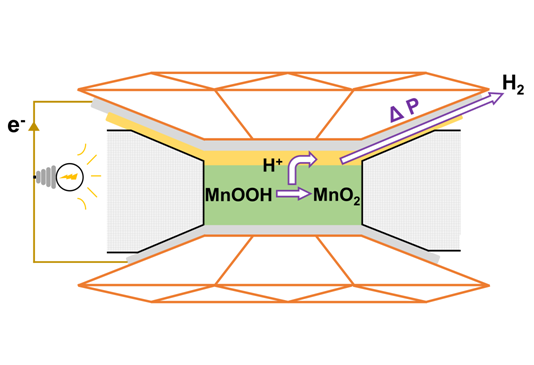Pressure-gradient-driven MnOOH dehydrogenation and prototype battery - Dr. Kuo Li
NOVEMBER 20, 2021
New work by a team of scientists led by Dr. Kuo Li from HPSTAR have found that pressure gradients across various hydrogen-bearing compounds, such as γ-MnOOH, can promote dehydrogenation. The team proposes a pressure-gradient-driven battery through this process by separating the transferring routes of protons and electrons. The results are published in the Journal of Physical Chemistry Letters.
Gigapascal (GPa) pressure is a robust force for driving phase transitions and chemical reactions with negative volume change and has widespread use for promoting combination/addition reactions. Through theoretical calculations and thermodynamic analysis, Dr. Kuo Li found that the pressure gradient across the diamond anvil cell sample chamber contributes even more to driving decomposition/elimination reactions.A pressure difference of tens of GPa can 'push' hydrogen out of its compounds from the high-pressure region into the environment.
The team applied a pressure gradient of ∼30 GPa across a sample of MnOOH and measured its properties through in situ x-ray diffraction experiments. In doing so, the hydrogen is squeezed out and migrates to lower pressure environments. In transition metal hydroxides like MnOOH, the protons and electrons of hydrogen can even be separated via different conductors, pushed out by the high pressure, and recombine outside under ambient conditions. This, in turn, creates a closed circuit, and a prototype pressure-gradient-driven battery can be constructed.
This investigation demonstrates that the pressure gradient can be used as an advantage, as a powerful tool to drive decomposition and electrochemical reactions.

Caption: Schematic diagram of pressure-gradient-driven battery based on a diamond anvil cell.
压力和温度是决定物质稳定性和反应性的两大热力学因素,绝大多数高压下的研究是基于静水压的假设。然而,当引入压力梯度作为热力学驱动力时,一个原子从100 GPa的高压环境中“挤出”到常压环境,系统的焓将会降低大约10 eV,压力梯度带来的巨大的能量足以破坏化学键,从而引发反应。近日,北京高压科学研究中心的李阔研究员课题组通过理论计算以及高压原位同步辐射X射线衍射实验发现许多含氢化合物,比如MnOOH,可以在压力梯度的驱动下发生脱氢分解反应。他们通过在金刚石对顶砧装置上耦合质子-电子分离传输线路,成功将此分解反应设计成电化学过程,并在高压原位直流电测试中观察到了电流,据此进一步提出了压差电池的模型。这项工作揭示了压力梯度对于分解反应是一种强大的驱动力,并且通过压差电池模型,可以直接将机械能转变为电能。该结果发表在近期的Journal of Physical Chemistry Letters (DOI: 10.1021/acs.jpclett.1c03382)上,文章第一作者为北京高压科学研究中心博士生王一达。
